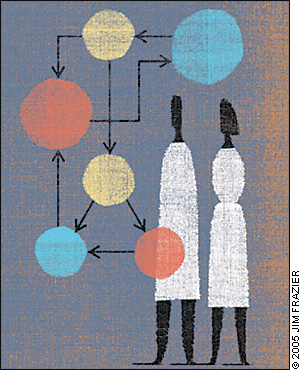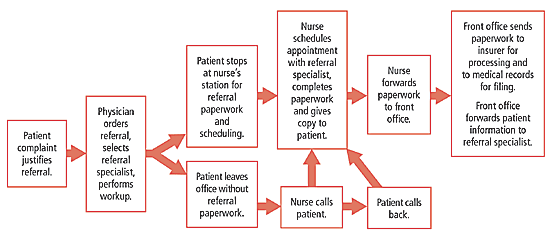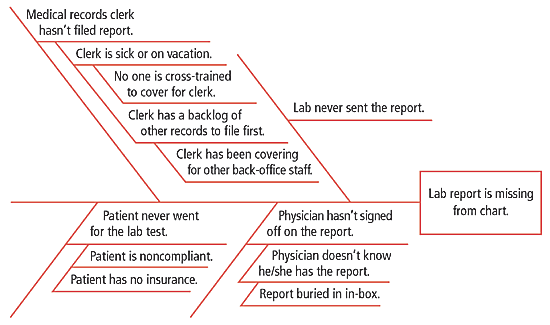
Using proven techniques borrowed from the business world, you can eliminate bottlenecks and waste in your practice.
Fam Pract Manag. 2005;12(4):61-66

The exam rooms aren’t stocked, I can’t find the nurse when I need help, the check-in process takes too long, we’re behind schedule, and there’s too much paperwork to complete. Sound familiar? These are all situations that raise our blood pressure as physicians. Often, they are symptoms of a larger office workflow problem, and fixing it requires that we review the symptoms, diagnose the problem and apply treatment, just as we do with our patients.
But while we know how to diagnose and treat our patients’ problems, we don’t always know how to diagnose and treat our office’s problems. The key is to employ proven quality improvement techniques used throughout the business world to increase efficiency and quality while decreasing costs. Many of these techniques originated decades ago in the manufacturing industry but have gradually made their way into service industries, including health care. Using these tools in your office can improve your efficiency, quality and bottom line as well.
KEY POINTS
Efficient processes are important because they require less time, effort and resources to produce better outcomes.
A flow map can be a powerful tool in identifying where your current process is breaking down.
Tools such as daily huddles can improve communication among staff and help you anticipate challenges in your workday.
Map your current process
Most problems within a practice can be traced back to a process problem, as opposed to a people problem. Efficient processes are important because they require less time, effort and resources to produce better outcomes. For each process in your practice, such as checking in patients or making referrals, a series of steps must be accomplished correctly, in the right order and at the right time to produce the best outcome. Drawing a picture (or flow map) of exactly how the process currently occurs can be a powerful tool in helping you understand the symptoms.
To create a flow map, use whatever format is most comfortable to you and simply list the current steps in order of completion. It’s usually best to begin at the point where the patient engages the process. For example, if referrals are a headache in your office and you decide to map the flow of referrals, start at the point where the patient relays symptoms to you that justify referral. Use “baby steps” to identify every subsequent step that occurs, and soon you will end up with a detailed description of the current process. (See an example.)
Flow mapping will help you clarify and standardize complex processes, and it can reveal complexity in seemingly simple processes. In one clinic, patients weren’t able to reach the triage nurse in a timely manner. Over a period of weeks, the clinic staff and physicians added sticky notes to the wall of the break room to demonstrate each step that occurred from the moment a patient called the office until he or she reached the triage nurse. To the staff’s amazement, the flow map ended up covering most of the wall. Once they saw all of the steps and the complexity of the process, they were able to begin thinking of ways to simplify and improve it.
FLOW MAP
To understand the current process for a key activity in your practice and assess where it might be going wrong, simply map out the steps in the order they occur. A sample flow map of a practice’s referral process is shown here

Identify bottlenecks and waste
Once you have identified each of the steps in your current process, you can begin to identify what is wrong with the process. Quality experts James Womack and Daniel Jones advise organizations to challenge each step of a process and consider whether it is valuable, capable, available, adequate and flexible.1 In other words, does the step create value for the customer, or is it a waste of time and energy? Does it produce good results every time, or does it fail repeatedly and require correction or rework? Is it available whenever it is needed to do the work, or is it often broken or delayed? Is it sufficient to meet the demand, or does it result in a bottleneck or lead to excess capacity? Can it adapt quickly to fluctuations, or is it inflexible?
As you identify problems with the cur rent process, you’ll need to eliminate steps that are simply waste and implement changes in your practice to make the remaining steps effective. For example, one of the most common process problems is a bottleneck, which is a blockade to increased output. Bottlenecks may occur all of the time, or they may be episodic. (An example of an episodic bottleneck is a staff shortage when a key staff member calls in sick or takes vacation.)
If your bottleneck is the result of a staff shortage, the solution may be to cross train your staff to perform key functions or cultivate relationships with other sources of staffing, such as temporary agencies. If your bottleneck is constant, you may need to devote more staff or resources to that step or find a better way of accomplishing it.
Another common process problem is unnecessary motion, such as leaving the exam room to look for equipment, supplies, your nurse or a certain reference. Stocking your exam rooms on a regular basis and in a standardized way is one solution. Having an electronic pharmacy tool can enable you to check drug interactions and dosages without leaving the exam room. If you don’t have access to electronic tools, posting an up-to-date drug reference in each exam room can be useful.
If you are having difficulty determining where your process is breaking down or why a process takes so long to complete, you may need to perform some time measurements. Measuring the amount of time for each step in a mapped flow chart can help identify bottlenecks and waste. To measure the cycle time of a process, have a staff member follow several patients through the entire process with a stopwatch at different times of the day. (See the example.) Add the average times for each step to come up with the total cycle time for the process.
You may find that the process takes significantly longer than the actual work involved. For example, the entire process of seeing a patient (from check-in to checkout) may take 40 minutes in your practice, although the actual amount of work in that process may require just 20 minutes. In other words, there may be 20 minutes of waste and waiting involved in each visit.
CYCLE TIME
Cycle time measurement helps reveal bottlenecks and waste within a process. To assess cycle time, follow each step of a process and measure the amount of time currently required to complete it. An example of the cycle time for an office visit is shown here. Note that at least half of the time spent would be considered non-value-added.
| Step | Time spent |
|---|---|
| Patient arrives at doctor’s office and checks in with receptionist. | 1 minute |
| Receptionist verifies patient insurance and collects co-pay. | 5 minutes |
| Patient waits in waiting room. | 13 minutes |
| Nurse escorts patient to exam room and takes vital signs. | 3 minutes |
| Patient waits in exam room. | 7 minutes |
| Physician examines and treats patient. | 8 minutes |
| Patient checks out with receptionist, if needed. | 3 minutes |
| Total cycle time | 40 minutes |
| Total time spent waiting | 20 minutes |
| Total time spent with nurse or physician | 11 minutes |
| Total time spent in administrative tasks | 9 minutes |
If you encounter a process that is continually problematic, you may need to be more formal about evaluating the causes of the breakdowns in the process. One graphic way to evaluate the possible causes is to develop a cause and effect diagram, also known as a fishbone diagram.
To create a cause and effect diagram, identify the problem (or effect) you want to address and ask yourself why this problem occurs. Using the format shown in this article, begin to write down your answers. For each answer, ask “why” again and again until you have enough detail to improve the process. For example, you may have a problem getting laboratory results into the chart in time for the patient’s next visit. If you ask why this problem is occurring, one answer may be that the reports are still with the physician waiting for sign-off. Again, ask why. Perhaps the physician doesn’t know he or she has the reports because the reports are getting buried in the physician’s in-box. Once you identify the root causes, you can begin to brainstorm solutions. One solution may be to create a centralized location for lab and test reports in the physician’s office.
Another way to create a cause and effect diagram is to post a large piece of paper in your break room. Draw the basic structure of the diagram, and ask your staff members to add their answers to the question, “Why did this problem occur?”
Over a period of one or two weeks, you and your staff may have a new understanding of the reasons that the process breaks down. At that point, you can agree on and map the new and improved process.
CAUSE AND EFFECT DIAGRAM
To create a cause and effect (or fishbone) diagram, write the problem inside a small box on the right hand of a sheet of paper. Draw a horizontal line to the left of the box and diagonal lines on each side of the horizontal line. Then, list possible causes on each diagonal line. For each cause, list any subsequent causes, and so on. The diagram shown here illustrates the reasons a test result may be missing from a chart during a patient visit.

Help the new process succeed
Once you have mapped your current process, identified its problems and agreed on an improved process, your work isn’t over. For the new process to succeed, you’ll need to take additional steps.
Staff education. Educating your personnel about the new process and equipping them with all the information they will need is vital to your success. For example, if you are trying to improve your referral process, make sure all of your staff members understand the rules of each of your third-party payers in detail. Additional and ongoing training in this area may help improve the process.
Job functions. You may also find that job functions need to be redesigned. If your nurses are handling referrals and also being asked to place patients into exam rooms in a timely manner, they are not likely to make referrals their highest priority. This choice is beneficial for overall office flow, but it does impair the flow of the referral process.
Improving the referral process may require streamlining the nurses’ job design or modifying another staff member’s job design so that he or she can manage referrals. In general, using your most highly trained staff members to perform tasks only they can perform will improve your staff’s efficiency.
Daily huddles. Visit planning, commonly referred to as an “office huddle,” is a tool you can use to identify and prepare for any variations that may occur in the process that day. At the start of each day (or each session), quickly gather your team of employees to assess the day’s workload and anticipate challenges. For example, if your schedule shows that Mrs. Smith is coming in today for a diabetes check-up, your nurse would scan her file and see that she hasn’t been in to see the ophthalmologist in over a year. Having the staff prepare the referral before Mrs. Smith’s appointment will expedite the process once she arrives.
Patient education. Educating your patients about your office processes can improve efficiency as well. Education can be one-on-one, such as having a staff member thoroughly explain a process in advance, or it can be fairly simple, such as a sign or visual cue. For example, if you need patients to stop by the nursing station to schedule their referral appointments before they leave, a well-worded sign in the exam rooms can improve the process.
Preparing patients for upcoming activities can also improve flow. If you order an ECG, make sure you give the patient a gown before exiting the room. This allows the patient to change clothes while the nurse is preparing the ECG machine, thus minimizing delays.
Teamwork. Improving office flow requires everyone, from the front desk staff to the physicians, to be involved in the improvement process. You cannot mandate a new process and expect it to succeed, so make sure your physicians and staff believe in it.
To develop a culture of teamwork, help your team see the mission of your office and the vision for what you want it to become. If your vision is for your office to become the quality leader among primary care practices in your area, articulate that clearly to your personnel. When you make decisions about the management of your office, tell your staff how that decision will further your mission and vision. This will bring a shared sense of purpose to your workplace.
10 RULES FOR AN EFFICIENT PROCESS
The quality improvement literature and the advice of experts in “lean thinking” suggest several rules for building an efficient process:
Clarify the value or purpose of the process from the customer’s perspective.
Eliminate any steps that do not add value.
Don’t batch and queue. Instead, deal with the patient or task as it presents to you, keeping the process flowing continuously.
Standardize the process so that employees follow the same steps every time, eliminating the need for guesswork.
Strive for fewer handoffs, allowing employees to be responsible for a complete task.
Simplify the process wherever possible with fewer steps and fewer people involved.
Eliminate waits and delays both within and between steps.
Correct errors or defects at the moment they occur. Don’t send them ahead to the next step in the process.
Question the movement of people or things within a process.
Don’t set up a task force to improve your processes. Instead, begin immediately by making someone accountable for the continuous improvement of each key process and letting the people who do the work improve the work.
Dream big, start small
Every office has the potential to achieve efficient flow throughout all of its processes. However, doing so requires deliberate efforts and hard work. Start by tackling just a few key areas within your practice, those one or two processes that cause continual headaches for you, your staff or your patients. Even a small process improvement can yield enormous gains in productivity, patient satisfaction and quality of care.